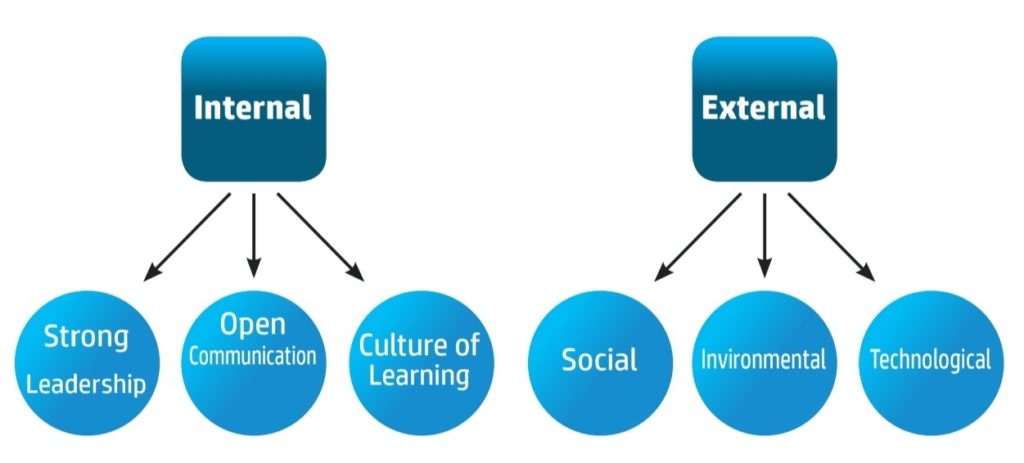Culture is so important these days that without a good culture, an organization may fail to innovate, develop trust and respect and be not able to clearly communicate its vision to its stakeholders. In today’s context developing a culture of growth becomes all the more necessary to stay competitive and to keep employees happy.
Before we can delve deeper into growth culture, let’s define culture. In simple terms, it is the collective values, beliefs, philosophy, and ways of working of an organization that fosters growth, opportunity, learning, innovation and effective collaboration with internal and external stakeholders and partners that guide the strategic business objective of an organization.
In today’s VUCA (Volatile, Uncertain, Complex and Ambiguous) world, adopting a strategy that aligns with the culture of an organization is not an easy task. On one hand there is a technological disruption that is happening with digital being the norm, and on the other hand, we have millennial’s joining the workforce in very large numbers. There is a need, therefore, to replace old systems and processes with new systems and processes that match the expectation of the current workforce and at the same time maintaining a balance with the existing norms and procedures. Let’s see how we can do this.
“Among the key pillars of organization growth such as the strength of the leadership, quality of employees, a focus on innovation, company culture is the one that has the greatest impact that determines if an organization will sustain itself in the long term.”
Creating an environment where high caliber people are suitably challenged, fully engaged and working in the zone of peak performance, but not performance-obsessed, becomes utmost important and necessary in order to become a growth-focused organization.
In a wonderful book titled, “Immunity to Change”, authors Robert Kegan and Lisa Lahey have dissected this topic by telling us that are 4 components that an organization should consider in order to build such a culture. Those components are:
- Building an environment of trust.
- A focus on continuous learning.
- Time-limited, manageable experiments with new behaviors to test.unconscious assumptions.
- Continuous feedback across the organization.
What we need to keep in mind that everything starts at the top and like they say in Germany the fish starts to stink at the head first. Therefore, if there is strong leadership at the top, it will guide the rest of the organization in building a culture of growth.
Let us look at the factors that would influence growth in an organization. At the onset, there are internal and external factors that may determine whether an organization will grow exponentially or not. The internal factors usually determine how a self-contained organization can move forward. The external factors are usually political, social, economic or technological in nature. If leadership can keep these factors in mind while recruiting, or while rewarding performance or when defining rules, norms, procedures, processes, and practices it helps to build a sustainable growth culture in the long run.
Factors That Influence Growth
What would the internal factors look like? It starts with great leadership that inspires and directs its vision in a manner that with its proper implementation will deliver the desired outcomes.
Communication comes next, with Trust as a major factor to focus on. Open and honest communication that is two-way in nature, and one that opens us the transparency that gets rid of communication deficiencies will help develop a robust growth culture.
The most important internal factor is usually building a culture of learning that fosters innovation with a focus on performance efficiency. If employees are not given an opportunity to learn and grow they will soon move into another organization that provides that.
Coming to the external factors, having a clear sense of mission is of utmost importance. Learning from the external environment and effectively communicating its impact will foster an ongoing exchange of ideas that would benefit all. Understanding the needs of the market and that of customers and providing real value to both will enhance the image and trust of the organization to the outside world. An organization needs to keep in mind that society plays a vital role in its success and should align its vision, mission, and strategy towards achieving those.

Mindset For Growth
Carol Dweck, professor of psychology at Stanford University, in her bestselling book, “Mindset”, talks about two types of mindsets. According to her, those are the Fixed mindset and Growth mindset. She says, “In a growth mindset, people believe that their most basic abilities can be developed through dedication and hard work—brains and talent are just the starting point. This view creates a love of learning and a resilience that is essential for great accomplishment”.Organizations too need to have a growth mindset culture.
One of the major obstacles of a growth mindset culture is that the company’s policies do not reflect a true commitment to growth and a lack of understand what a growth mindset is. Overcoming these obstacles by revising practices, policies, and systems that enhance not just performance, but also learning, growth, and progress will lead it towards the right trajectory.
Sustaining A Growth Culture
Let us look at a few facets to consider to maintain a growth culture. We are well aware that building a culture of growth is one challenging aspect, but on the other side maintaining it long-term is the greatest challenge. A few things can be considered here.
- Hiring for culture-fit
- Training leaders to inspire others
- A focus on growing people through coaching and mentoring programs
- Effectively communicating shared values to establish standards and protocols that will enable a growth culture.
Conclusion
Companies such as Zappos, Southwest Airlines and Google have managed to build a culture that empowers its employees and gives them the flexibility, freedom, and opportunity to grow both personally and professionally, and no wonder these are the ones that everyone looks forward to being employed with. Building such a culture is not rocket science but with the right leadership, employees with a great attitude and a culture that rewards and gives merit in the right form will surely able to build and sustain a growth culture.









